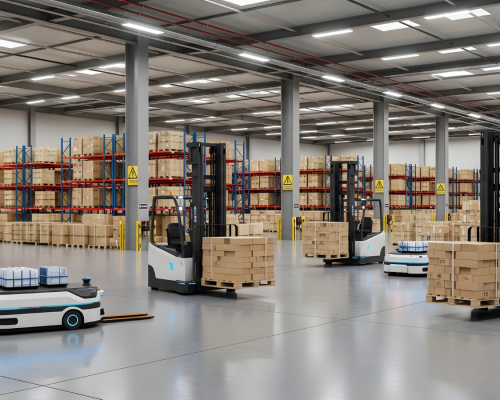LiDAR Collision
Avoidance System
Our LiDAR collision avoidance system (LCAS) delivers precision safety across a range of commercial and industrial equipment—from forklifts and AMRs to AGVs, construction machinery, and vehicles. By delivering real-time, high-resolution 3D sensing, LCAS enables advanced awareness and proactive hazard mitigation in dynamic environments.
Applications
LCAS excels across mission-critical applications:
- Forklifts and AMRs/AGVs: enhance safety and efficiency in warehouses and distribution centers.
- Construction equipment: maintain secure operations on rugged job sites.
- Commercial and utility vehicles: augment driver awareness and collision prevention in mixed-traffic zones.

Why LiDAR Outperforms Cameras for Collision Avoidance
- Consistent performance in any lighting—unlike cameras, LiDAR isn’t impacted by glare, shadows, or darkness.
- True 3D spatial data—provides vertical and horizontal detection to capture low-lying debris or overhead hazards—areas where cameras often fail.
- Robust low-latency sensing—critical for split-second collision avoidance decisions.
These strengths make LiDAR an increasingly cost-effective and reliable choice for collision systems.
Driving Down Costs
Advances in solid-state LiDAR have significantly reduced sensor costs while enhancing reliability and uptime.
LiDAR sensors used for LCAS applications range from $2,000 to $10,000, depending on exact requirements.
Aftermarket / Retrofit solutions like MicroVision’s L‑CAS offer a cost-effective option for upgrading existing vehicles,
achieving a higher level of safety without requiring full vehicle replacements.
Collision Avoidance Use Cases
Pallet detection
Identify low-profile hazards on warehouse floors.
Aisle-edge detection
prevent cornering or aisle boundary collisions.
Drop detection
sense sudden floor elevation changes—like loading dock edges.
Pedestrian safety
alert or halt when humans enter the vehicle path.
Vehicle-to-vehicle avoidance
sense moving equipment in shared spaces
Overhead object detection
capture obstacles above the vehicle—e.g., hanging pipes or racking.
General obstacle detection
immediate response to unexpected obstructions.
Benefits for Businesses
- Reduced damage to building structures, racking systems, and machinery
- Fewer injuries and lower workers’ compensation claims
- Lower liability and maintenance costs through proactive accident prevention
- Enhanced job site mobility with safer navigation in dynamic environments
- Less downtime caused by accidents, equipment repairs, or safety investigations
- Improved operational efficiency by keeping workflows uninterrupted
- Stronger safety culture that protects employees and assets alike
Object Identification vs. Object Detection
Detection: recognizes the presence of an object (e.g., “an obstacle ahead”).
Identification: classifies detected objects (e.g., “this is a pedestrian vs. a pallet”).
Use cases that require nuanced response, such as slowing for humans but not for static objects, benefit from object identification capability. LCAS-equipped systems often combine both for optimized safety logic. For applications requiring only object detection, a lower resolution (and lower cost) sensor can typically be used along with less sophisticated software.
On-Vehicle vs. Fixed-Mounted LCAS
On‑Vehicle Systems: LiDAR sensors mounted directly on moving equipment provide real-time, immediate proximity awareness.
Fixed‑Mounted Systems: LiDAR units installed in the facility (e.g., on overhead beams or stationary poles) monitor zones and can trigger automated responses or alerts.
Each approach has strategic advantages. Fixed position systems typically require longer range and higher resolution in order to have sufficient detection capability from an elevated mounting position. If only a fixed number of locations are being monitored, this could significantly reduce the cost of implementation by avoiding the purchase of an LCAS system for every forklift. In some cases, LCAS systems are implemented in a grid pattern across entire warehouses in order to achieve full coverage. One of the downsides to this is being able to identify each forklift and alert drivers in real time. However, there are companies, like Fort Robotics, that do have software solutions to mitigate that concern.
On-vehicle systems are more effective in highly interactive environments, where people and other vehicles can come from any directly at any time. And especially if a view from above cannot provide sufficient coverage. For example, some collision avoidance systems need to operate inside of shipping containers during unloading. This requires an on-vehicle solution unless the lidar can be mounted at every dock door with a sufficient FOV to see inside the container.
Integration With Braking Systems
PROS
Rapid, automated response in imminent collision events.
Consistent safety regardless of operator input.
CONS
Requires rigorous validation to avoid unintended braking.
Potential integration cost and complexity.
LCAS can be configured to trigger warnings only, or active braking, based on client preference and system maturity.
Ready To Implement Collision Avoidance?
Set up a call with one of our engineers to discuss your application and we’ll determine the most cost-efficient hardware and software solution. At US LiDAR, we have the industry expertise, technical know-how, and proven solutions to get you the safety and efficiency improvements you’re looking for.
Contact us to discuss your collision avoidance application today.